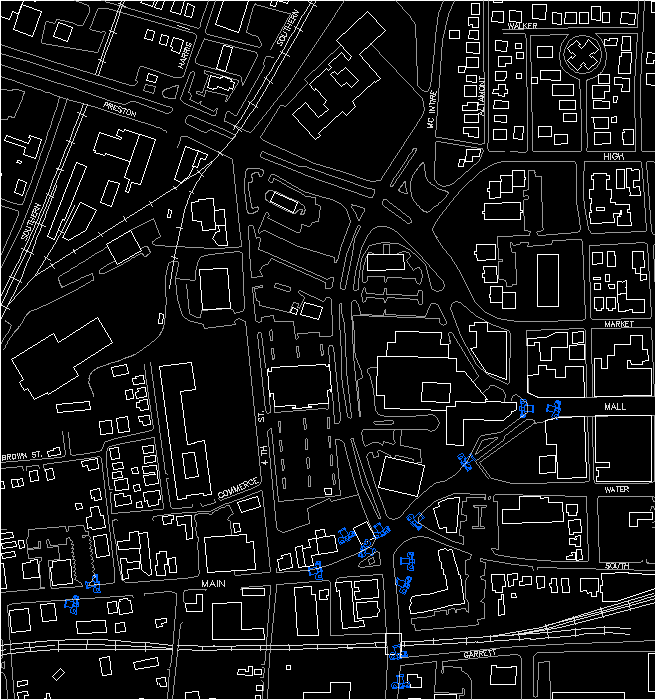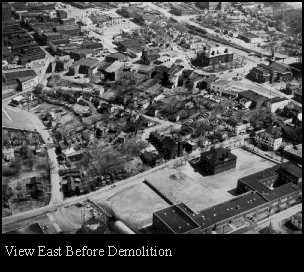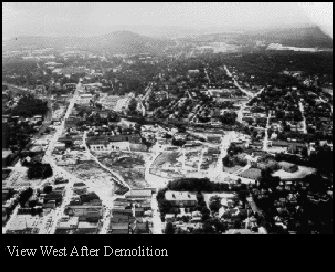
Vinegar Hill site plan, c. 1974. Touch camera symbols for current photographs
 Vinegar Hill site plan, c. 1974. Touch camera symbols for current photographs |
| Introduction |
| History of Vinegar Hill |
| History of Charlottesville |
| Graphic Analysis |
| Context Map |
| Charlottesville Archive |
| Feedback |
In the most strict interpretation, "Vinegar Hill" refers to the segment of West Main Street as it moves from Second Street, SW up to Fourth Street. Early in the nineteenth century, this portion of Main Street also acquired the name of Random Row in recognition of the way that the street deviates from the regular grid of the original town plan. The gentle curve of the street, combined with a rather steep incline produced a series of stepping and mostly detached structures along both sides of the street. Most interpretations would suggest that the triangular area defined by Main Street on the South, Preston Avenue on the north and Fourth Street on the west constitutes the Vinegar Hill area, immediately to the west of the original downtown grid of Charlottesville.
Vinegar Hill was largely demolished in the mid-1960's as a part of Charlottesville's "urban renewal" campaign. The political forces within the city saw a derelict slum that had developed on the hillside immediately adjoining the downtown district. At the same time, peripheral areas beyond downtown had begun to draw commerce away from the central district and some form of revitalization was seen as necessary to staunch the flow. In addition, there was no smooth north-south connection through the downtown area of Charlottesville, and ease of automobile and bus transportation was seen as a high priority, especially for the Greyhound franchise which stood at the top of Vinegar Hill on Main Street. All of these factors combined with available federal money and a very thinly disguised racist agenda of slum clearing in an area so close to the reputable downtown business district to produce the nearly wholesale destruction of a neighborhood that was uncommonly rich in its own heritage, traditions and lore within Charlottesville.
The elimination of the principal area of commerce for the African-American population of Charlottesville, in close proximity to the city high school, cannot be seen in isolation. While the community only temporarily succeeded in avoiding integration, the destruction of Vinegar Hill has had a profound and long lasting effect on the identity and economic health of a formerly cohesive neighborhood. As early as 1976, John Hammond Moore identified some of the many shortcomings of such a violent urban act:
"The Hill, now swept bare by an urban renewal scheme which seems to have faltered, then had forty-one buildings on the north side of the street and sixteen on the south..... Vinegar Hill did not burn down nor did all the "bad folks" disappear when that sordid but colorful jumble of buildings was razed. Center of bootleg activity and vice it was, but the hill most assuredly was much more vibrant and alive in its former guise than it is today, now merely an expanse of bare ground stretching like a no-man's-land, perhaps to be the site of the downtown business district's last stand should the upstart shopping centers mushrooming a few miles to the west ever launch an all-out attack". Moore. p. 165
The hope of an area, cleared of unhygienic slums, miraculously evolving into a vibrant component of a revitalized downtown district has not been realized. Urbanistically, the area has followed a number of planning and architectural formulas from the 1950's and 60's. These involve the primacy of the automobile in its smooth operation at fairly high speeds through the city, serviced and supported by ample areas of grade parking, in which an occasional building is placed. As a strategy, this is in direct contrast to the fundamental relationship that existed in this area between building and street, between a clearly discernible front versus back of each property, between the amenities and social support of the public realm.

| 
|
It would be impossible to resurrect Vinegar Hill in its earlier form, and few would be interested in the problems of drainage and the absence of sewer hookups and running water that many of the properties had to endure. However, some form of reconstruction can be imagined, and one hopes that this new interest in the area can seriously consider the rich history of the place and the memory of its former residents.
| Vinegar Hill Urban History, Extended | Vinegar Hill Photograph Archive | Charlottesville Bibliography |
 Charlottesville Archive
Charlottesville Archive
| Bibliography | Make a suggestion |
 IATH WWW
Server
IATH WWW
Server